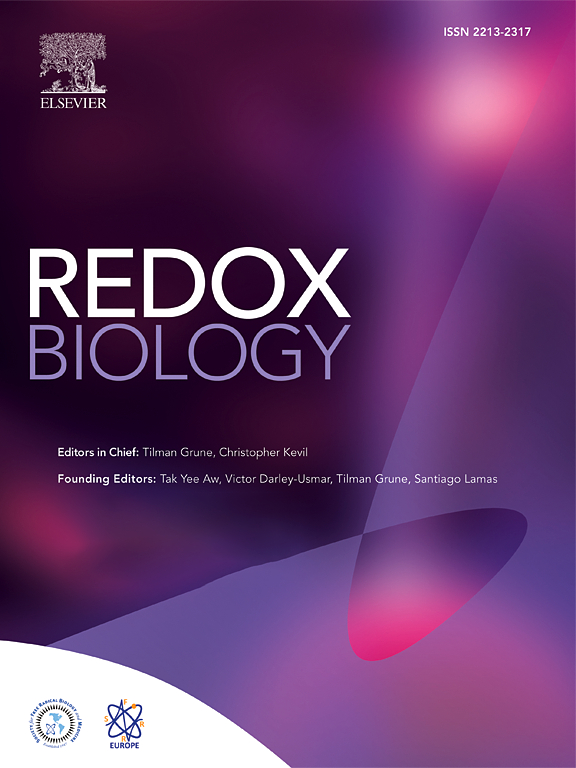一种新型查尔酮衍生共价Keap1结合剂的发现,可减轻顺铂诱导的线粒体功能障碍和肾毒性
IF 11.9
1区 生物学
Q1 BIOCHEMISTRY & MOLECULAR BIOLOGY
引用次数: 0
摘要
顺铂引起的肾损伤(CIKI)是这种广泛使用的化疗药物的主要不良反应。针对CIKI中涉及的关键事件,如炎症、细胞凋亡、线粒体功能障碍和氧化应激,有可能减轻CIKI并改善患者预后。在此,我们报道了一种新的含n查尔酮衍生物作为半胱氨酸靶向Keap1的共价结合剂,通过激活Keap1- nrf2 - are信号有效减轻顺铂(CDDP)诱导的线粒体功能障碍(CIMD)和CIKI。最初,查尔酮衍生物(A6)通过内部化合物的高通量发光筛选被确定为强Nrf2激动剂。经过两轮结构优化,我们开发了一种新的含n查尔酮衍生物(C5),该衍生物具有增强的Nrf2激动剂活性,良好的药物样性质,并提高了肾脏靶向能力。细胞和动物研究表明,C5通过激活Keap1-Nrf2-ARE信号通路,在两种情况下显著改善cddp诱导的肾细胞和CIKI小鼠的CIMD和CIKI。在机制上,C5共价修饰Keap1中两个关键功能半胱氨酸(IVR结构域的C288和Kelch结构域的C319),协同放大Nrf2的激活。作为一种非常有效的Nrf2激动剂,C5通过协调抗氧化防御、提高线粒体能量、促进线粒体生物发生、恢复线粒体动力学和抑制随后的凋亡级联激活来减轻CIKI。此外,Nrf2敲低显著减弱了C5在CIKI小鼠中的肾保护作用,证实了Keap1-Nrf2信号通路在其肾保护机制中的关键作用。总之,一种新的含n查尔酮衍生物被开发出来,作为一种有效的肾靶向Keap1共价结合剂,为对抗CIKI提供了一种有前景的治疗候选药物。本文章由计算机程序翻译,如有差异,请以英文原文为准。
Discovery of a novel chalcone-derived covalent Keap1 binder for mitigating cisplatin-induced mitochondrial dysfunction and nephrotoxicity
Cisplatin-induced kidney injury (CIKI) is a major adverse effect of this widely used chemotherapy agent. Targeting key events involved in CIKI, such as inflammation, apoptosis, mitochondrial dysfunction and oxidative stress, holds potential for mitigating CIKI and improving patient outcomes. Herein, we report a novel N-containing chalcone derivative as a cysteine-targeting covalent binder of Keap1, which effectively mitigate cisplatin (CDDP)-induced mitochondrial dysfunction (CIMD) and CIKI through activating Keap1-Nrf2-ARE signaling. Initially, a chalcone derivative (A6) was identified as a strong Nrf2 agonist through high-throughput luminescence screening of in-house compounds. After two rounds of structural optimization, we developed a novel N-containing chalcone derivative (C5), which exhibits enhanced Nrf2 agonist activity, favorable drug-like properties, and improved renal-targeting ability. Cellular and animal studies showed that C5 significantly ameliorated CIMD and CIKI in CDDP-induced nephrocytes and CIKI mice via activating the Keap1-Nrf2-ARE signaling pathway in both settings. Mechanistically, C5 covalently modified Keap1 on two critical functional cysteines in Keap1 (Cys288 in the IVR domain and Cys319 in the Kelch domain), synergistically amplifying Nrf2 activation. As an extremely potent Nrf2 agonist, C5 mitigated CIKI by orchestrating antioxidant defenses, boosting mitochondrial energetics, promoting mitochondrial biogenesis, restoring mitochondrial dynamics, and inhibiting subsequent apoptotic cascade activation. Furthermore, Nrf2 knockdown markedly attenuated the nephroprotective effects of C5 in CIKI mice, confirming the critical role of Keap1-Nrf2 signaling in its nephroprotective mechanism. Collectively, a novel N-containing chalcone derivative was developed as an efficacious and renal-targeting covalent binder of Keap1, offering a promising therapeutic candidate for combating CIKI.
求助全文
通过发布文献求助,成功后即可免费获取论文全文。
去求助
来源期刊

Redox Biology
BIOCHEMISTRY & MOLECULAR BIOLOGY-
CiteScore
19.90
自引率
3.50%
发文量
318
审稿时长
25 days
期刊介绍:
Redox Biology is the official journal of the Society for Redox Biology and Medicine and the Society for Free Radical Research-Europe. It is also affiliated with the International Society for Free Radical Research (SFRRI). This journal serves as a platform for publishing pioneering research, innovative methods, and comprehensive review articles in the field of redox biology, encompassing both health and disease.
Redox Biology welcomes various forms of contributions, including research articles (short or full communications), methods, mini-reviews, and commentaries. Through its diverse range of published content, Redox Biology aims to foster advancements and insights in the understanding of redox biology and its implications.
 求助内容:
求助内容: 应助结果提醒方式:
应助结果提醒方式:


